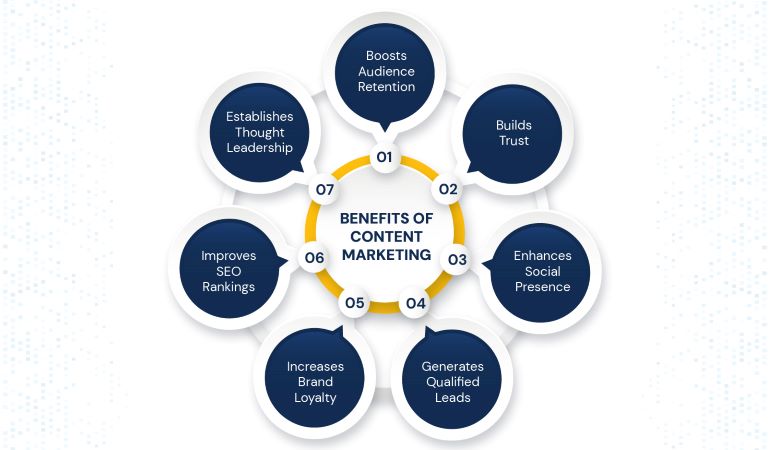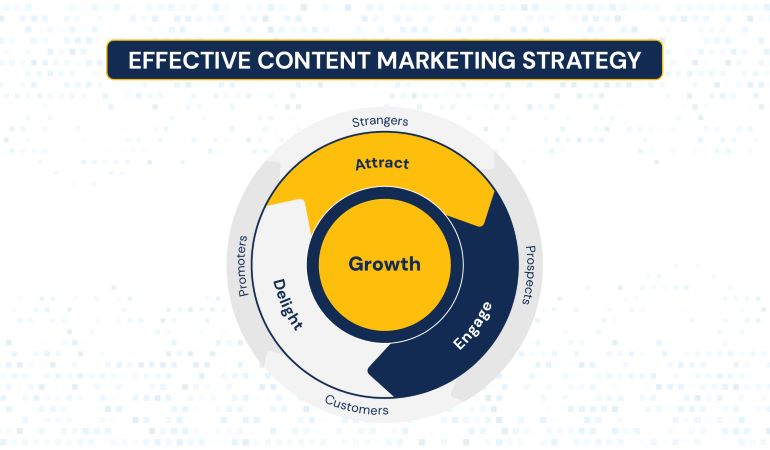
Over the last couple of decades, marketing techniques have significantly evolved. As people turn to digital products and services, businesses have also created new ways to brand themselves. And why not? Failure to adopt the latest technological trends seriously impedes a company’s chances of survival, let alone thriving. Content marketing has emerged as a proven way to increase a brand’s digital footprint and improve customer retention and loyalty.
This article explains content marketing and why it is vital for your business.
What is Content Marketing?
Before we discuss how you can use content marketing to benefit your business, it is essential to explain what it is. Once you understand it better, you can use it effectively to build your brand reputation and improve your bottom line through customer-driven actions.
Content marketing is a strategic marketing technique of digital marketing services that seeks to create and distribute consistent, relevant, and high-quality content to win over and retain a clearly defined target audience. It involves creating and curating content for free to share with the target audience.
Content marketing helps you build an audience, attract relevant backlinks for SEO, improve website traffic, and turn leads into sales, thus enabling you to increase your profits. It helps marketers build a viable and trusting relationship with the audience by showcasing a brand and what it stands for.
The content you create and distribute via online channels should be engaging and relevant, i.e., it should address your audience’s pain points and add value for them. It should also drive them to take some action, like filling out a form or booking a free session with you. Featuring real-life products—such as Swarovski jewellery —in lifestyle content, for example, can help connect your offering to customer aspirations and drive conversions through emotional resonance.
Similarly, a brand can round out a styling article with a subtle, descriptive link to a crystal bracelet that mirrors the look shown, helping readers connect inspiration with a specific product page. This keeps the focus on education while creating a natural next step for interested readers.
The most crucial result of your content marketing strategy is to ensure that your website traffic improves and that those who visit your website become loyal visitors and return to it time and again to consume fun and helpful content.
You can use various types of content, including texts, images, videos, podcasts, social media posts, emails, blogs, etc., as part of your content marketing strategy. To keep such a diverse asset library organized and easy to repurpose, many teams adopt digital asset-management platforms—our quick primer on what is DAM shows how they streamline content workflows.
What is the Purpose of Content Marketing?
Content marketing aims to create relevant and useful content for your audiences, which will build credibility and trust for your business.
Customers are now smarter and more discerning. TV commercials, print ads, and promotional messages do not easily sway them. They know what they want and what is relevant to them.
Content marketers go beyond traditional marketing methods to create content that addresses customers’ problems and provides value. Much like professional assignment writers who tailor work to specific needs, content marketers craft materials that foster a long-term customer relationship, increase product or service sales, and establish brand authority.
Why Use Content Marketing?
Why do content marketing when traditional marketing techniques are time-tested? That is true; companies have long relied on TV and print ads and still have their use. But something completely changed customer behavior over the years – the internet.
The Internet made information readily available, so customers started doing their research, which impacted their purchasing decisions. That is why content marketing has significantly increased in importance in recent years.
Also, one reason why content marketing is so important is because of B2B businesses. B2B sale cycles are longer and more complex than B2C. Additionally, B2B customers require extensive research and information because they need assurance before making purchases on behalf of their business. This is also why content plays a central role in B2B lead generation. When businesses share valuable, data-driven insights, they’re not just educating potential buyers they’re attracting qualified prospects and guiding them through the decision-making process more effectively.
7 Benefits of Content Marketing
Here are some of the reasons you should consider investing your time, money, and efforts in content marketing strategy.

-
Enables Audience Retention
Content that moves your audience is an incredible asset for you. It helps you deliver great experiences to your audience and impels them to return for more. For instance, a brand that shares styling tips for jewellery or buying guides for diamond rings may find that customers return frequently for inspiration and advice. If you manage to create, curate, and deliver highly engaging and relevant content to your audience, rest assured they’ll return for more. Thus, it’s an opportunity to retain your audience and increase your brand awareness.
GoPro has an abundance of user-generated content that speaks to its high-quality products. They encourage users to share their adventures captured with GoPro cameras, which the company then features on its platforms. In this way, they only curate the content and spread their message through word of mouth.
-
Builds Trust
Content marketing really helps you build trust between your brand and your audience. When people know they can turn to your blog or YouTube channel to learn and get answers to their questions, they will begin to trust you. Besides, another critical factor that drives the trust-building process is the fact that you distribute your content for free, hence no strings attached.
As a result, when your content reaches your target audience at the right time and place, your brand reputation will soar. It will help them associate your brand with valuable content that resonates with them and helps them solve their issues.
CeraVe, a skincare brand, has cracked the content marketing code. They consulted with dermatologists to create content with authentic and expert-endorsed information about skincare. CeraVe’s customers can find credible skincare advice on its platform, which strengthens their trust in the brand.
-
Improves Social Media Presence
Have you heard of viral content? How does a meme or a short video go viral in a matter of a few hours and days? Such trendy content not only helps you grow your social media followers but also compels them to engage with it and, by extension, your brand. Marketing automation helps you create such content, thus helping you increase your social media traction and presence.
BuzzFeed’s “Tasty” videos are the best example of this. They created a series of short, visually appealing recipe videos that went viral on social media. The videos were not only captivating but also provided step-by-step guides for different recipes. BuzzFeed’s visibility grew exponentially after this, leading to better engagement and reaching new audiences.
-
Generates More Qualified Leads
Content marketing is known for helping a company generate marketing-qualified leads (MQLs). These leads satisfy the criteria you set for your ICP (ideal customer profile). Your marketing team engages with MQLs to facilitate their buyer’s journey down the marketing funnel before handing them over to the sales team for eventual sales. However, you need access to certain user information, like name, company, position at the company, what they’re looking for, etc., before qualifying it as an MQL.
CTAs (calls-to-action) perform a critical role in lead generation. You can place these CTAs anywhere in your content, at the top or bottom of the page, in-line, or on the side panel. Great content drives your audience to click on the CTAs and move down the marketing funnel.
A personal finance platform, Intuit Mint, used its personal finance blog, “MintLife,” to offer valuable financial advice and resources. They concentrated on content that included how-to guides on financial matters, such as:
- Paying for college
- Buying a house
- Paying student loans
They also included in-depth interviews and advice on how to deal with financial disasters. The result? Mint reached 10 million users in three years because of the blog’s relevant and informational content.
-
Improves Brand Awareness and Loyalty
You can build brand awareness and enhance customer loyalty using content marketing. You create a raving fan base by creating and delivering content that moves your audience and resonates with them on a deeper level.
Even if they haven’t purchased from you yet, these fans will most likely become your brand advocates. They will thus influence other people’s buying decisions, adding value to your brand.
Red Bull produces and shares extreme sports content through videos, sponsored events, and sponsorship. Their media team focuses on making feature films and magazines about extreme sports, men’s lifestyle, and culture.
-
Elevates your SERP Ranking
Quality content helps you rank better on various search engines, including Google and Bing. A robust SEO (search engine optimization) strategy will bolster your investment in developing fun, easy-to-read, high-quality content. Then, you can enhance the discoverability of your content for AI search with Generative Engine Optimization (GEO), a strategic approach where articles and product pages are optimized with carefully-selected phrases and keywords that improve search visibility for AI results and LLMs, and firms like Skale are already integrating GEO practices into their content workflows.
An SEO strategy only works well when it optimizes already good content. So, once you have good content and you pair it up with SEO, your digital presence and visibility will significantly increase. And in the digital realm, it’s all about besting your online competitors with better-quality content and SEO benefits.
For example, Google’s new Hummingbird algorithm now ranks pages based on semantic SEO. If your website has a lot of accurate information on a topic, it creates a topical authority for that subject.
Your website becomes trustworthy in the eyes of both the search engine and the users.
-
Positions you as a Thought Leader
Content marketing is an incredibly effective way to gain authority for your brand in your specific niche. If you can place your brand as an established authority on a particular domain or niche, it will automatically improve your SERP ranking.
Besides making you a thought leader in your niche, it will help build trust between your brand and the audience. You can only achieve this much-sought-after mantle if you offer valuable content that answers your audience’s concerns and strikes a chord with their emotions and needs.
Patagonia is an example of a company doing effective content marketing. It is an outdoor clothing brand that positions itself as an industry leader by sharing content on eco-friendly products and sustainability.
How to Create an Effective Content Marketing Strategy
Developing a content map is one of the best ways to create an effective content marketing strategy. It is also an industry practice, as many organizations create content maps to support their marketing strategies.

A content map outlines what content you will deliver at each stage. Here are some of the typical stages:
-
Awareness
At this stage, customers know they have a problem but are unaware of your brand. So, to inform and attract potential customers, you create educational content that addresses their questions. The awareness stage aims to inform the customers, not compel them to purchase or take any action.
-
Consideration
You have the customer’s interest! That’s great, but now it’s your job to help them evaluate their options by presenting your product or service as a potential solution.
The content in the consideration phase focuses on in-depth details, such as:
- How-To Guides
- Service Demos
- Case Studies
- Webinars or Seminars
To execute these Consideration-stage assets at a high standard, many brands partner with a creative content agency. Leveraging The Motion Agency’s creative content expertise can turn research insights into cohesive case studies, product demos, and webinar narratives, then adapt them into social cutdowns and short-form video. This ensures brand voice and visual identity stay consistent across channels while accelerating production alongside your DAM and marketing automation.
-
Decision
In this stage, the customer has decided to make a purchase but hasn’t yet decided on a vendor. To win the customer over, you need to convince the prospect to choose your product or service through testimonials, reviews, and success stories.
-
Retention
Once the prospect has chosen you, you must ensure they remain a long-term customer. Retention requires strengthening relationships and fostering brand loyalty.
Make content that reinforces your product or service and engages customers to help them maximize their investment.
Conclusion
More and more companies are investing their resources in content marketing to develop a robust digital presence and reap the benefits of this fantastic marketing strategy. Although it takes time for content marketing to deliver results, it is totally worth it. Now is the best time to invest in your content marketing strategy to reap its benefits in the months and years ahead.
If you want enterprise web presence solutions, drop your query at [email protected].
